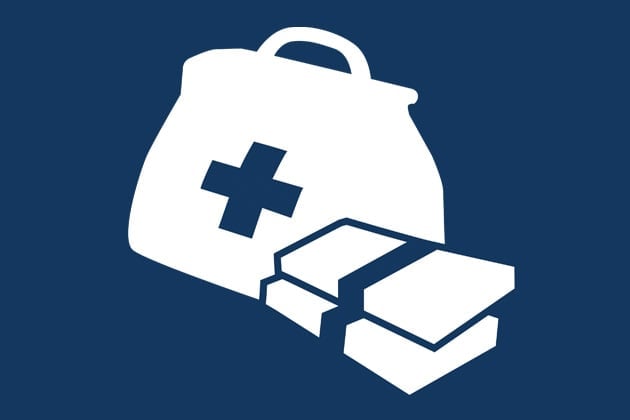- Joined
- Nov 21, 1998
- Messages
- 12,563
- Reaction score
- 6,951
See attached: I appreciate our colleagues stepping up in these unprecedented times and uncharted waters.
Summary of Recommendations to Outpatient Musculoskeletal and Pain Physicians:
1. Continue to see patients when clinically necessary.
2. Avoid blanket in-office and procedure cancellations, which can potentially lead to
unnecessary patient suffering.
3. Make use of telehealth services as appropriate to meet the needs of our patients.
4. Prevent further emergency room overload and strain by providing acute services when
possible.
5. Reduce requirements for PPE for simple joint and spine procedures that have a very low
risk of infection.
6. Exercise caution with the use of corticosteroids, particularly in higher risk patients who
may be immunocompromised.
As musculoskeletal and spine specialists, we aim to achieve functional improvement in patients
with a variety of impairments and disabilities. We need to strike the balance between exposing
patients and staff to the virus and providing treatment for our patients. Further, a balance is
needed in caring for critical patients with COVID-19 while still being able to care for the
community in need. There will still be patients that have serious medical conditions and require
immediate care. When a procedure is deemed “elective and non-urgent” this does not
necessarily mean that the patient can wait. Some “elective” procedures should be performed in
order to prevent worsening of the condition and further decompensation of the patient. We
recommend that consideration of pain level, suffering and potential for functional loss should
be integrated into future governmental and societal procedure recommendations.
As always, treatment decisions need to be individualized on a case-by-case basis to identify the
optimal approach for each patient. The climate created by COVID-19 is ever-changing and with
it specific treatment recommendations, however with a thoughtful approach we will be able to
navigate the COVID-19 pandemic with the least disruption for our patient population.
Sincerely,
Gene Tekmyster, DO
Board-Certified in Physical Medicine & Rehabilitation and Sports Medicine
Assistant Professor - Keck School of Medicine of USC, Department of Clinical Orthopaedic
Surgery
Team Physician - US Ski & Snowboard
Maxim Moradian, MD
Board-Certified in Physical Medicine & Rehabilitation, Sports Medicine, Pain Medicine, and
Regenerative Medicine
David W. Lee, MD
Board-Certified in Physical Medicine & Rehabilitation, and Pain Medicine
Shounuck I Patel, DO, MMS
Board-Certified in Physical Medicine & Rehabilitation, and Sports Medicine
Clinical Assistant Professor - Western University of Health Sciences
Clinical Assistant Professor - Touro University College of Osteopathic Medicine
Gerard Malanga, MD
Board-Certified in Physical Medicine & Rehabilitation, Sports Medicine, and Pain Medicine
Assistant Professor - Rutgers University
Gary P Chimes, MD, PhD
Board-Certified in Physical Medicine & Rehabilitation, and Sports Medicine
Rahul Desai, MD
Board-Certified in Radiology
President - Interventional Orthobiologics Foundation
Jaspal Ricky Singh, MD
Board-Certified in Physical Medicine & Rehabilitation, Sports Medicine, and Pain Medicine
Vice Chair and Associate Professor - Weill Cornell Medicine, Department of Rehabilitation
Medicine
Prathap Jayaram, MD
Board-Certified in Physical Medicine & Rehabilitation, and Sports Medicine
Director of Regenerative Sports Medicine - Baylor College of Medicine
Assistant Professor - Baylor College of Medicine, Departments of Physical Medicine &
Rehabilitation, and Orthopedic Surgery
References:
1. Haynes BF, Fauci AS. The differential effect of in vivo hydrocortisone on the kinetics of
subpopulations of human peripheral blood thymus-derived lymphocytes. J Clin Invest 1978;
61:703.
2. Dixon WG, Abrahamowicz M, et al. Immediate and delayed impact of oral glucocorticoid
therapy on risk of serious infection in older patients with rheumatoid arthritis: a nested
case-control analysis. Ann Rheum Dis. 2012;71(7):1128.
Summary of Recommendations to Outpatient Musculoskeletal and Pain Physicians:
1. Continue to see patients when clinically necessary.
2. Avoid blanket in-office and procedure cancellations, which can potentially lead to
unnecessary patient suffering.
3. Make use of telehealth services as appropriate to meet the needs of our patients.
4. Prevent further emergency room overload and strain by providing acute services when
possible.
5. Reduce requirements for PPE for simple joint and spine procedures that have a very low
risk of infection.
6. Exercise caution with the use of corticosteroids, particularly in higher risk patients who
may be immunocompromised.
As musculoskeletal and spine specialists, we aim to achieve functional improvement in patients
with a variety of impairments and disabilities. We need to strike the balance between exposing
patients and staff to the virus and providing treatment for our patients. Further, a balance is
needed in caring for critical patients with COVID-19 while still being able to care for the
community in need. There will still be patients that have serious medical conditions and require
immediate care. When a procedure is deemed “elective and non-urgent” this does not
necessarily mean that the patient can wait. Some “elective” procedures should be performed in
order to prevent worsening of the condition and further decompensation of the patient. We
recommend that consideration of pain level, suffering and potential for functional loss should
be integrated into future governmental and societal procedure recommendations.
As always, treatment decisions need to be individualized on a case-by-case basis to identify the
optimal approach for each patient. The climate created by COVID-19 is ever-changing and with
it specific treatment recommendations, however with a thoughtful approach we will be able to
navigate the COVID-19 pandemic with the least disruption for our patient population.
Sincerely,
Gene Tekmyster, DO
Board-Certified in Physical Medicine & Rehabilitation and Sports Medicine
Assistant Professor - Keck School of Medicine of USC, Department of Clinical Orthopaedic
Surgery
Team Physician - US Ski & Snowboard
Maxim Moradian, MD
Board-Certified in Physical Medicine & Rehabilitation, Sports Medicine, Pain Medicine, and
Regenerative Medicine
David W. Lee, MD
Board-Certified in Physical Medicine & Rehabilitation, and Pain Medicine
Shounuck I Patel, DO, MMS
Board-Certified in Physical Medicine & Rehabilitation, and Sports Medicine
Clinical Assistant Professor - Western University of Health Sciences
Clinical Assistant Professor - Touro University College of Osteopathic Medicine
Gerard Malanga, MD
Board-Certified in Physical Medicine & Rehabilitation, Sports Medicine, and Pain Medicine
Assistant Professor - Rutgers University
Gary P Chimes, MD, PhD
Board-Certified in Physical Medicine & Rehabilitation, and Sports Medicine
Rahul Desai, MD
Board-Certified in Radiology
President - Interventional Orthobiologics Foundation
Jaspal Ricky Singh, MD
Board-Certified in Physical Medicine & Rehabilitation, Sports Medicine, and Pain Medicine
Vice Chair and Associate Professor - Weill Cornell Medicine, Department of Rehabilitation
Medicine
Prathap Jayaram, MD
Board-Certified in Physical Medicine & Rehabilitation, and Sports Medicine
Director of Regenerative Sports Medicine - Baylor College of Medicine
Assistant Professor - Baylor College of Medicine, Departments of Physical Medicine &
Rehabilitation, and Orthopedic Surgery
References:
1. Haynes BF, Fauci AS. The differential effect of in vivo hydrocortisone on the kinetics of
subpopulations of human peripheral blood thymus-derived lymphocytes. J Clin Invest 1978;
61:703.
2. Dixon WG, Abrahamowicz M, et al. Immediate and delayed impact of oral glucocorticoid
therapy on risk of serious infection in older patients with rheumatoid arthritis: a nested
case-control analysis. Ann Rheum Dis. 2012;71(7):1128.


